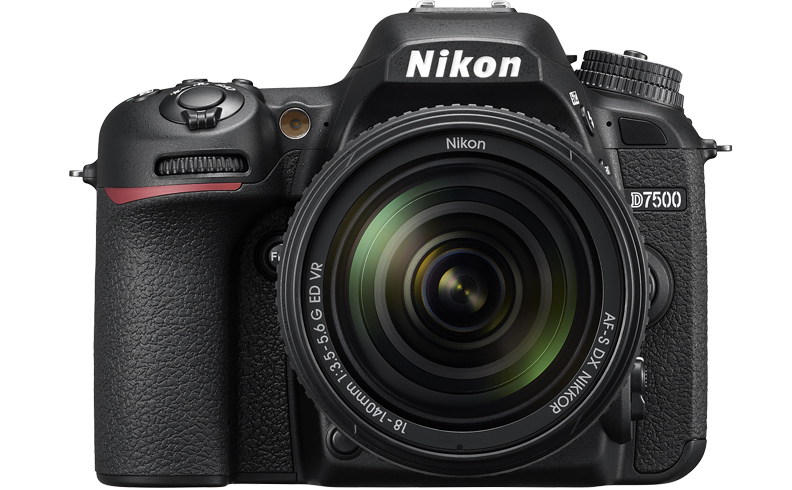Impressive image quality with Outstanding Operability

Primary Features
1. The high-performance EXPEED 5 image-processing engine enables the same image quality as the D500
The D7500 is equipped with the same high-performance EXPEED 5 image-processing engine found in the D500. It supports the ISO 100-51200 range of standard sensitivities*, and the synergistic effects of utilization with the Nikon DX-format CMOS sensor, with its effective pixel count of 20.9-million pixels and no optical low-pass filter, ensure very sharp and clear photos and movies in which noise is suppressed, even when shooting at high sensitivities.
- *The range of supported ISO sensitivities can be extended to Lo 1 (ISO 50 equivalent) and up to Hi 5 (ISO 1640000 equivalent).
2. High-speed continuous shooting of up to approx. 50 shots at around 8 fps (14-bit lossless compressed RAW)
EXPEED 5's high-speed image-processing and a larger memory buffer have made high-speed continuous shooting at approximately 8 fps*1 possible. Up to 50 images in 14-bit lossless compressed RAW, or up to 100 JPEG images can be captured with each burst of continuous shooting*2, ensuring certain capture of the perfect moment.
- *1 With continuous-servo AF mode, manual or shutter-priority auto exposure, a shutter speed of 1/250s or faster, and all other settings at default values.
- *2 When a 16-GB SanDisk SDHC UHS-I memory card is used, and an ISO sensitivity setting of ISO 100 is applied. More or fewer shots may be possible depending upon shooting conditions and/or camera settings.
3. The accuracy of AF and AE has been greatly increased with the adoption of a 180K-pixel RGB sensor
Adoption of the same 180K-pixel (approximately 180,000 pixels) RGB sensor used by the D500 increases the accuracy of automatically controlled functions, including AF and AE, auto white balance and Active D-Lighting. The D7500 is also equipped with a flicker reduction function for still images and highlight-weighted metering mode enabling support for a broad variety of scenes. Furthermore, group-area AF has been adopted for the 51-point AF system that uses the Advanced Multi-CAM 3500 II autofocus sensor module. Five focus points are utilized to acquire the subject within the frame, easily keeping even erratically moving subjects in focus. There is also an AF fine-tune function that supports auto fine-tuning, making precise focus adjustment for each lens easy.
4. 4K UHD (3840 x 2160) movies for incredibly sharp and clear imaging expression
The D7500 supports the same 4K UHD (3840 x 2160)/30p movie recording possible with the D500. The maximum recording time for movies of this resolution is approximately 29 minutes 59 seconds. What's more, movie files can now be recorded in the MP4/AAC format commonly supported by smart devices, making it easier to view your movies on a variety of devices. Time-lapse movies can be created in 4K UHD format within the camera and can be output to an external device via HDMI as they are recorded to the in-camera SD memory card. Furthermore, the electronic vibration reduction, which reduces the effects of camera shake in hand-held recording, and Active D-Lighting can be applied with recording of Full-HD and HD movies.
5. Superior agility and operation from a slimmer and lighter system
The D7500 is equipped with a 3.2-inch high-resolution monitor that can be used to perform a number of operations, including shooting using Touch AF and Touch Shutter (with still-image photography) as well as to scroll rapidly through images with playback using the frame advance bar. Adoption of a tilting mechanism allows users to more comfortably shoot from a broader variety of angles. In addition, a monocoque structure made of a strong and durable carbon fiber composite material has been adopted for the camera body, reducing its weight to approximately 720 g*. The deep grip made possible by the slim body makes for an even firmer hold on the camera.
- *Measured in accordance with CIPA standards including the battery and SD memory card, excluding body cap.
- Similar in size to the D7200, just a slightly slimmer body and more comfortable grip
- Auto Picture Control, with which the camera automatically adjusts tone curve, color, sharpness and clarity in accordance with the scene.
- Multiple exposure function that permits users to preview partially overlaid images of the final composite during the shooting process or delete the most recent frame and reshoot. All shots that make up a multiple exposure can be saved individually.
- In-camera RAW batch processing of a great number of images, such as with interval timer shooting.
- Power-saving design that enables recording of up to approximately 950* still images, and approximately 80 minutes* of movies with a single charge when the EN-EL15a Rechargeable Li-ion Battery is used.
7. The downsides
- Lesser in battery life - 950 shots per full battery, D7200 had 1,110
- No dual-card slot (negative compared to the D7200, which has dual-card slots)
- No battery grip option
- LCD screen resolution went down to 922,000 dots (the D7200 had 1,228,800 dots)
Article source here.





